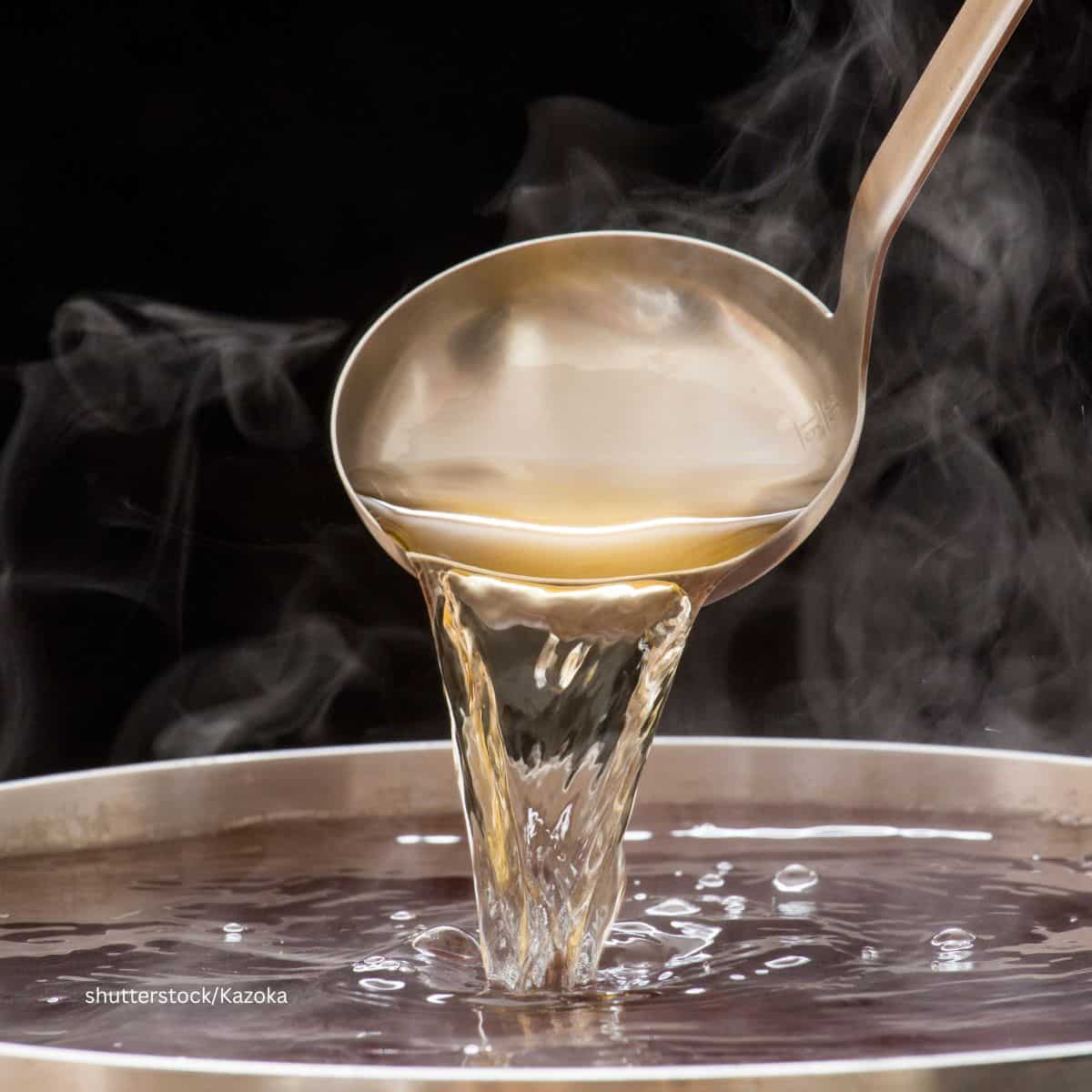Dashi is one of the most prominent flavors in Japanese cooking and has started to get more popular in other cuisines as well. It’s a great way to add some umami and complexity to your meals and can be a versatile tool in your kitchen.
Just one problem, Dashi might not be an option for a lot of people.
For one thing, Dashi almost always includes fish, which means that people who are allergic to certain fish, follow a vegan or vegetarian diet, or have other restrictions might not be able to use it.
The other big issue is that Dashi, for all it’s versatility, can be hard to find in Western grocery stores.

The good news is that there are a lot of potential substitutes for Dashi stock or instant Dashi seasoning. Here are a few of the best options.
| Substitute | Flavor Profile |
| Shitake Mushrooms and Seaweed Broth | Sweeter, with strong seafood flavor and a mellow umami. |
| Soy Sauce | Salty, slightly bitter, and umami. |
| Oyster Sauce | Salty, bitter, sweet, umami, slight shellfish undertone |
| Instant Dashi Powder | Umami, fishy taste, some saltiness. |
| Chicken Broth | Sweeter, gently fatty, some umami |
| Kombu Powder | Strong seaweed flavor, slightly sweeter than other seaweed options. |
| Dried Bonito Flakes | Strong fishy umami flavor |
| Bullion | Variable, depending on the kind of bullion. |
| Lobster or Crab Boullion | Strong shellfish, sweet, and salty flavor. |
| Stock | Depends on the type of stock, but usually tastes strongly of the aromatics with some umami undertones. |
| MSG | Pure umami. |
| Mushroom Stock | Earthy, umami, may be sweet or bitter depending on the mushrooms. |
Why Would You Want To Substitute Dashi?
There are a lot of reasons to substitute dashi. You might not like that flavor but want something similar enough to create an authentic taste. Or you might have a limited diet and need an alternative that is better for your diet preferences.
Dashi can also be hard to find, and the brands that area available can have varying quality. So it might be easier to substitute with a common or more consistent product like store-bought broths and stocks.
You might also just be looking for a way to save dinner after you realize you don’t have enough dashi on hand to make a planned meal.
Regardless of why you’re looking to replace Dashi, these alternatives should make it easier to get the right flavor for your meal!
The Best Dashi Substitutes And When To Use Them
Shitake Mushrooms and Seaweed Broth
This is a classic alternative and still offers a lot of authentic flavor, while also being vegan. Better yet, if you already have shitake mushrooms in the rest of the dish, you can use the wood stems to make the broth without needing another ingredient.
Add sesame seed oil to get even more umami, and miso paste or soy sauce if you want to replace the salty taste of dashi.
Speaking of shitake mushrooms, shitake and pork go really well together in Asian cooking. If you want more Asian pork recipes, we can help!
Benefits:
Easy to make, can offer anything from a mellow to an intense flavor, ingredients are more readily available.
Problems:
Less sodium (can also be a bonus), and the seaweed can get overpowering until you get the recipe down.
Soy Sauce
Soy sauce is probably the simplest substitute, but you’ll need very little, and it can make your dish taste a little one-note if you aren’t adding other sources of flavor in the sauce. Seaweed can help replace the ocean flavor of dashi, and a small amount of soy sauce can help add some umami, and the sodium to make a successful Japanese dish.
Benefits:
Easy to use, highly available, and probably already in your kitchen.
Problems:
Lots of sodium contains gluten (choose tamari for a gluten-free alternative) less umami, may already be in your recipe.
Oyster Sauce
Oyster sauce is another good option, but it’s easy to add too much. It’s also a little more bitter than typical dashi, so you might want to add a little sugar or honey to get a more balanced flavor.
Also, you need very little to replace dashi. Japanese cooking often relies on a harmony of delicate flavor, and too much oyster sauce can overwhelm the other flavors.
Benefits:
Closer flavor profile than most alternatives.
Problems:
May already be in your recipe, may make your dish taste Chinese rather than Japanese, easy to overdo.
Instant Dashi Powder
Instant dashi is probably the form of dashi that is most common in the U.S. and other Western countries and is a good, but not perfect, replacement. Keeping a little instant dashi on hand can help adjust the seasoning of a dish last minute, and also works well for dishes where the dashi isn’t a primary flavor.
But, it can taste a little flat on it’s own, compared with regular dashi.
Benefits:
Easy to use, easier to order online, you can make exactly as much as you need.
Problems:
Flavors less well-rounded than regular dashi, fewer ingredient options in general.
Chicken Broth
Chicken broth might not seem like a good substitute at first, but its umami and subtle flavor actually make for a great replacement. Chicken broth is neutral, slightly sweet, slightly salty, and has some umami when done well. That hits all the checks for a dashi replacement, plus it’s a more familiar flavor for a lot of people.
Benefits:
Incredibly easy to get. Versatile, and you may already have some on hand.
Problems:
Less strongly flavorful than dashi, and the umami is less potent.
Kombu Powder
Kombu powder is a good dashi replacement if you can get it. However, like dashi, you’ll probably need to order it online or get it from a specialty Asian or Japanese grocery store.
Kombu on its own is often the vegetarian alternative to dashi, and some dashi products are actually made from just kombu, without bonito or other dried fish.
For the ocean taste of dashi, there aren’t many better alternatives.
Benefits:
Kombu is often included in dashi, along with bonito flakes, so this gives a very authentic flavor.
Problems:
Kombu alone adds less umami and richness than dashi with bonito.
Dried Bonito Flakes
On the other hand, if you don’t like that strong seaweed flavor from kombu, but do enjoy the umami and saltiness of dashi, bonito flakes can be a good alternative. You can use them to create your own broth, and also as a seasoning so people can customize the flavor of their plate to their liking.
Benefits:
Bonito flakes are the other half of many dashi products, so this is also a very authentic flavor.
Problems:
Can feel salty and too fishy unless you balance the bonito. May make umami the primary or overpowering flavor of your dish.
Bullion
Bullion is an easy and fast alternative to dashi, and, if you choose the right flavors or brands, can come close to authentic flavors. It’s not usually made with seafood ingredients (the exception coming up next), but it’s a good way to add umami and salt to a dish without having to get an entirely different ingredient.
The most common issue is that bullion can taste pretty generic, and it can overpower the subtle flavors in Japanese cooking in some cases.
Benefits:
Readily available, can customize the kind of bullion for the dish you’re making.
Problems:
Generally salty, and can make your meals taste too generic or similar.
Lobster or Crab Bullion
The exception to generic-tasting bullion are lobster and crab bullions that are a bit closer to typical dashi stock. In fact, with a little tweaking, these can give you fantastic seafood flavor in your dishes and are useful for a wide range of different kinds of meals.
However, since these are a more concentrated flavor, it’s better to start with a little and add more gradually so you don’t get an overpowering taste from the bullion.
Benefits:
Probably the best dashi replacement in bullion form, this is a good dashi replacement that captures similar flavor.
Problems:
May overpower other flavors, especially delicate fish flavors common in Japanese cooking.
Stock
Stock, store-bought or homemade, is a great dashi alternative. Not to mention that dashi is technically a kind of stock, so this makes for a more traditional alternative.
Even vegetable stocks with added seaweed, ginger, or leeks can taste very similar to other Japanese components, which makes them a great addition. Chicken and duck stocks are also traditional, if you’re trying to get away from the seafood taste.
Benefits:
Stock is customizable, and adding a little ginger or seaweed to a pre-made stock can produce a very authentic flavor.
Problems:
Stock can be bland, too salty, or too overpowering for many Japanese dishes. You need to customize to get a good result.
MSG
Plain MSG can serve basically the same purpose in your Japanese cooking as Dashi. All it is is concentrated umami flavor, and it can actually heighten and bring out other flavors in your meal.
The biggest downsides aren’t actually related to the ingredient, but the fear and misconceptions about MSG that can make people nervous to cook with it or eat foods made with it.
Benefits:
Authentic Japanese cooking often uses MSG, and the umami flavor serves the same role as dashi in your cooking. Also easy to adjust how much MSG is in your dish.
Problems:
There aren’t many downsides, but myths about MSG and health may make some people nervous about eating food made with this ingredient.
Mushroom Stock
In cases where you want a very authentic flavor, but are vegan or vegetarian, or you’re trying to make a heartier meatier tasting meal, mushroom stock is a great option. You’ll make this yourself, usually with a variety of seasonal mushrooms and aromatics like onions, garlic, or ginger.
This is an authentic alternative, and can even work better in some dishes than a dashi stock. But it takes a little more work, and you may need to make it a few times before you find the right combination of mushrooms, water, and cooking time to get the right flavors.
Love mushrooms? Here are some Enoki mushroom recipes you can try, and who knows, maybe you’ll even make a custom mushroom stock for one of these meals!
Benefits:
Mushroom stock is an authentic replacement for dashi and may even be more suitable for some dishes.
Problems:
Strong earthy flavor can overwhelm subtler flavors.
Final Thoughts
Dashi is an incredible ingredient, but it isn’t perfect or irreplaceable. Hopefully, this list of potential Dashi replacements gave you some idea how to substitute for this ingredient in your cooking, as well as a sense of which replacements will work better in which dishes! Not sure what to serve with you Japanese meal? Well, this discussion of the differences between Soju and Sake should make choosing the right drink for your next dinner party easier.





